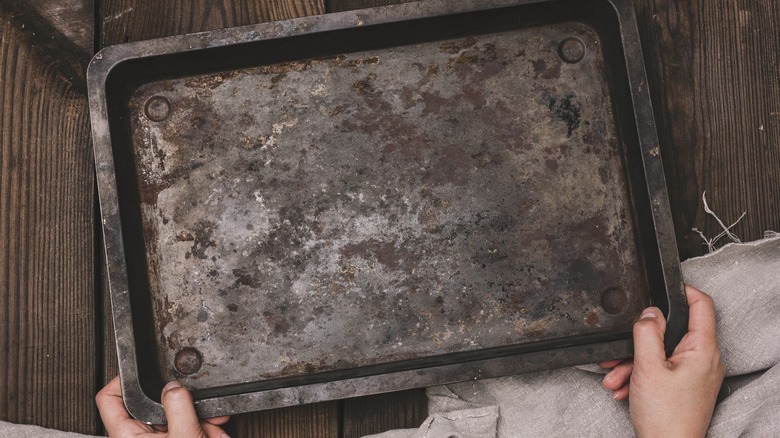Hardened Grime On Baking Sheets Stands No Chance Against This Coin Hack
If you've got well-loved baking sheets that suffer from hardened grime, you've probably already tried every cleaning solution under your sink. Sometimes dish soap, water, and elbow grease just don't cut it when food is baked onto cooking sheets. Fortunately, there's a simple and affordable trick you've got to try — and it will only cost you a penny! Forage in your change purse for your least expensive coin and you'll be surprised at how helpful it can be in cleaning your cookware. Using a penny to clean a baking tray is a simple yet effective kitchen hack that leverages the properties of copper to tackle stubborn residues. Copper, found in pennies made before 1982, exhibits antimicrobial and abrasive characteristics, making it an ideal material for scrubbing off baked-on grime. This hack works well on baking trays with a smooth surface, particularly those made of aluminum or stainless steel, as copper's softer composition helps avoid scratching these materials.
However, users should exercise caution when attempting this hack on non-stick or coated baking trays. The abrasive nature of the penny may compromise the fragile coating of these types of pans, leading to scratches and reducing the effectiveness of the non-stick surface. In these cases, it is advisable to use gentler cleaning methods — such as a soft sponge or nylon brush — to preserve their non-stick properties. Nevertheless, the penny cleaning hack is a handy and cost-effective solution for maintaining the cleanliness of aluminum or stainless steel baking trays.
How to clean baking sheets with a coin
Cleaning a baking tray with hardened grime using a penny is both straightforward and effective. To begin, gather the necessary materials: a dirty baking sheet, a pre-1982 copper penny, dish soap, and water. The copper penny, composed of a softer metal, is suitable for removing stubborn residues without damaging the baking sheet's surface. To begin, wet the baking sheet to soften the dried-on grime. You can either soak it in warm, soapy water or run hot water over the surface. This initial step helps loosen the hardened particles, making it easier for the penny to lift them off. Next, apply a small amount of dish soap directly onto the problem areas. The soap works in conjunction with the penny to break down grease and enhance the cleaning process.
Take the copper penny and, using moderate pressure, start scrubbing the baking sheet in circular or back-and-forth motions. Focus on the areas with the most significant grime buildup. The soft abrasiveness of the copper aids in dislodging the stubborn residues without causing scratches. Periodically rinse the penny and the baking sheet to remove dislodged grime, inspecting the progress and determining if additional attention is needed in certain spots.
Finally, thoroughly rinse the baking sheet to remove any remaining soap and residue, and dry it with a clean towel. The result should be a cleaner baking sheet, free from the hardened grime that may have seemed insurmountable before trying this simple yet effective cleaning method.
